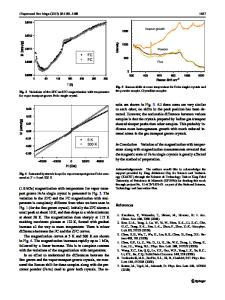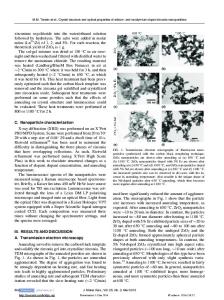Photoluminescence properties of yttria-stabilized zirconia single crystal
- PDF / 1,028,717 Bytes
- 5 Pages / 612 x 792 pts (letter) Page_size
- 39 Downloads / 347 Views
Shinji Itoh Materials Analysis Station, National Institute for Materials Science, Sengen 1-2-1, Tsukuba, Ibaraki 305-0047, Japan (Received 25 January 2004; accepted 13 May 2004)
The photoluminescence (PL) and PL excitation spectra of the single-crystal samples of yttria-stabilized zirconia (YSZ) were measured. We found that the PL spectra of two samples for the 280-nm excitation significantly differ from one another in intensity, although the two samples have the same macrostructure and the same chemical composition. These results indicate that PL spectroscopy is a useful method for studying the microstructure of YSZ. The result of the trace-impurity analysis suggests that the large difference in PL intensity between the two samples can be explained by considering the influence of Nb in the YSZ sample. It seems that Nb in YSZ caused an yttria-associated defect. The broad emission band around 550 nm would be attributed to this defect. These results suggest that information can be obtained from its PL measurement not only on the yttria-associated defect, but also on the trace impurity in the YSZ. I. INTRODUCTION
Yttria-stabilized zirconia (YSZ) is used in a variety of applications, such as fuel cells and oxygen sensors. Single-crystal YSZ is also used as a transparent substrate. For example, K1.9Ga1.9Sn6.1O16 (KGSO) thin films are prepared on the YSZ substrate, but not on a glass substrate because of devitrification of the glass during the film preparation.1 YSZ, (ZrO2)1−x(Y2O3)x, is stabilized in the cubic phase for x ⳱ 0.1 to 0.7 at room temperature, and it has a fluorite structure.2 Oxygen vacancies in YSZ are introduced by substitution of Y2O3 to preserve electrical neutrality. It is therefore necessary to understand the influences of oxygen vacancy on YSZ properties for their applications. Photoluminescence (PL) spectroscopy is a useful method for characterizing YSZ because the PL properties of YSZ reflect its chemical composition and its defects, as well as its electric band structure.3–10 This method could be used to evaluate the quality of the YSZ products. However, the PL property of YSZ is not yet fully understood. The influences of trace impurities in YSZ on its PL property are almost unknown. In this study, we measured the PL and PL excitation spectra of single-crystal YSZ samples, which were
a)
Address all correspondence to this author. e-mail: [email protected] DOI: 10.1557/JMR.2004.0298 J. Mater. Res., Vol. 19, No. 8, Aug 2004
characterized by their selected area diffraction (SAD) patterns, chemical compositions, and trace impurities. From these results, we considered the microstructure of the samples, and explained the influence of oxygen vacancy and a trace impurity in the samples on their PL properties. II. EXPERIMENTAL
The single-crystal YSZ samples used were commercial 10 mol% Y2O3-ZrO2 (100) (Shinkosha Co., Ltd.). The samples were square plates of 20-mm length and 0.5-mm thickness. The structural difference between the samples was examined by transmission electron microscopy (TE
Data Loading...








